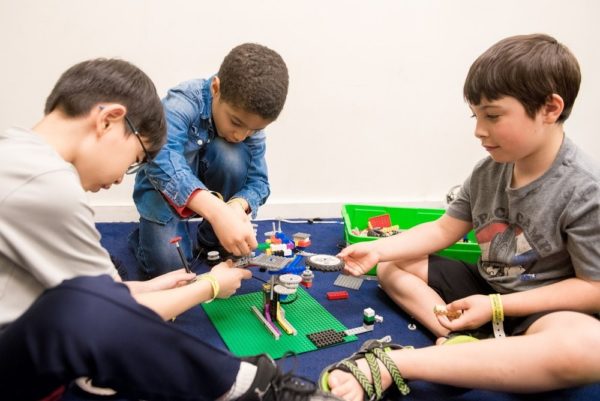Screen-free Coding and Makerspaces in School
When you hear about Makerspaces in elementary schools, what immediately comes to mind? Creativity? Ingenuity? Hands-on engineering? Makerspaces in schools are popping up everywhere but what are they and how can they help kids learn valuable STEAM and coding skills?
A Makerspace, sometimes referred to as a “Hackerspace,” is a place or community in which students can gather to work on projects, share ideas and innovation in coding and programming. Similarly, makerspaces in elementary schools are allowing children to get involved in technology at a young age and intertwine these literacies with other subjects. Markerspaces provide the best platform for kids to explore their interests, learn to use innovative tools, and develop creative projects with their peers.

Is Coding Fun?
The big question often asked today is, can coding be made to be fun for young children? The simple answer is yes! Coding like any other subject found in school, can be taught to appeal to young minds. They can grasp the concepts and enjoy the process if introduced in a specific way. Learning to code has trickled down through the PreK and elementary schools and many states have even adopted Computer Science standards starting at PreK.
“When you don’t create things, you become defined by your tastes rather than ability.” Programmers are artists who are continuously creating things and solving world problems. Teaching kids to code in makerspaces is a way to sharpen their intellectual creativity, problem-solving skills, algorithmic, sequential, and computational thinking skills in the most conducive environment possible. If your child or student is between the ages of 5 – 7 years old and you want them to begin learning to code, having them glued to a computer screen has been found to have negative consequences. Growing data suggests that exposing young children to too much time in front of a computer can have negative effects on their development, including issues with memory, attention and language skills. Which is why screen-free coding is on the rise.
What us screen-few coding and coding robots?
Screen-free coding robots are introducing young children to programming languages without the use of computers. They are engaging kids through the power of play, while simultaneously instilling practices and critical thinking skills that will have a lasting impact.
The right coding robot will not only offer the computational skills, but also combine creativity, imagination, and problem-solving abilities, which are essential for any real-world programmer. More makerspace classrooms are employing these screen-free coding robots and using them in curricula that spans technology, mathematics, literacy, art, geography, and even athletics.
Benefits of screen-fee coding and coding robots in Makerspces
The benefits of screen-free coding robots are immeasurable. It develops a child’s computational thinking by breaking down complex problems into smaller components when learning to code. This problem-solving ability is transferable to real life situations they encounter problems and even real-world programming.

Screen-free coding robots also encourage experimentation. In makerspace classes (unlike in your typical classroom), children can learn that sometimes the answers to problems are not always straightforward. They reason, and even determine that more than one solution to a particular problem may occur. These robots encourage creativity through art, experimentation building and design.
Makerspaces develop persistence, resilience, and perseverance versus sitting at a desk and listening to lectures. It’s hands-on, experiential learning at it’s finest. Using coding robots to learn programming languages in Makerspace improves collaboration and communication skills as well. Children often work together to solve problems, create and complete activities, and discuss their concepts to the class. They end up sharing similar interests, introducing peers to new ideas, and it fosters a knowledge-base among young children.
KIBO, the learning robot designed specifically for kids, offers an inviting, engaging platform for young children to start their journey into creating with code in a fun and creative way. KIBO’s block-based coding language gives children control over the robot’s movements, sounds, and sensors, allowing them to express their imaginations with code. The KIBO curriculum for educators also teaches children to tell stories, create characters, and explore the world around them through code. KIBO is the number one choice in screen-free coding for kids – trusted by more parents and schools to introduce today’s youth to the wonders of technology and robotics.
Learn the 6 Key Benefits of Using Robotics with Your Youngest Students!
![]() Introduce coding and robotics into your early childhood classrooms – in a fun and playful way!
Introduce coding and robotics into your early childhood classrooms – in a fun and playful way!



















